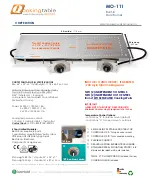
20
Carolina Cooker®
844-478-4334
Model M78097
June 2020
8. Transporting
Transporting the appliance should be done in an open bed
truck or trailer.
1. Remove the LP cylinder from the appliance prior to
transporting.
2. Make sure the appliance and any cooking liquid is
cool to the touch before transporting.
3. Do not transport the LP cylinder inside a vehicle
containing passengers unless it has a separate
cargo space.
a. Make sure the tank is leak-free before placing
inside a vehicle or trailer.
b. Transport the tank in an upright position, never
on its side.
c. Place the tank on a flat surface.
d. Place the tank in a rack or restrain it from
movement when transporting to prevent tipping
or other damage.
9. Storage
1. Store the appliance in a dry place.
2. Do not store the appliance outside where it would be
exposed to the weather.
3. Indoor storage of the appliance is permissible only
if the LP cylinder is disconnected and removed from
this appliance. Refer to section “3.7 LP (Propane) Gas
and LP Cylinder Safety” on page 8.
4. Store the appliance away from the reach of children.
5. For long-term storage, cover the burners and close
the air shutter to prevent potential blockage.
6. Check and tighten any loose hardware or
connections at the beginning of each new season.
7. Keep the appliance area clear and free from
combustible materials, gasoline, and other
flammable vapors and liquids.
4. If you feel you must use soap, clean your cast iron
with hot water, a clean cloth, and a mild dish washing
detergent.
a. Wipe any oils or food residue with a cloth or
paper towel.
b. Wash the pot with a nonabrasive dish brush,
sponge, or dishcloth and a small amount of mild
dish washing detergent.
c. Rinse the pot with hot water.
d. Place the pot back onto the burner to completely
dry it. This should only take a minute or two.
e. Carefully coat the inside of the HOT pot with a
thin layer of flaxseed, sunflower, or soybean oil
using an oil-soaked paper towel.
f. Place the pot over the burner just long enough to
evaporate any water in or on the pot.
g. Allow the pot to cool to ambient room
temperature and store in a dry location.
5. Cast iron will rust easily.
a. Do not leave water in the pot when not in use.
b. Do not leave the pot outside where it would be
exposed to the elements.
c. To remove any trace of water, place the pot over
the burner just long enough to evaporate any
water in or on the pot.
6. Do not use harsh detergents on the cast iron pot
and/or lid.
7. Oil the cast iron pot with flaxseed, sunflower, or soy
bean oil.
8. Avoid, if possible, cooking acidic foods such as
tomatoes.







































